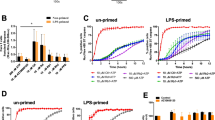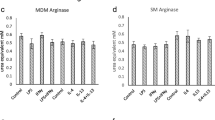Abstract
Rat alveolar macrophages incubated with recombinant rat interferon-γ producel-arginine-dependent nitric oxide, which is rapidly decomposed into nitrite: this production by interferon-γ was markedly enhanced by granulocyte-macrophage colony-stimulating factor and muramyldipeptide, but not by other cytokines. The enhancement was dependent on the presence ofl-arginine in the incubation medium. It was based on a simple synergism between interferon-γ and muramyldipeptide and a priming effect of granulocyte-macrophage colony-stimulating factor for interferon-γ-induced nitrite production. These data suggest that cytokine networks are important in the induction of nitric oxide in rat alveolar macrophages.
Similar content being viewed by others
References
Y. Sibille and H. J. Reynolds,Macrophages and polymorphonuclear neutrophils in lung defense and injury. Am. Rev. Respir. Dis.41, 471–501 (1990).
D. J. Stuehr and M. A. Marletta,Induction of nitrite/nitrate synthesis in murine macrophages by BCG infection, lymphokines, or interferon-γ. J. Immunol.139, 518–525 (1987).
J. B. Hibbs, R. R. Taintor and Z. Vavrin,Macrophage cytotoxicity: role for l-arginine deiminase and imino nitrogen oxidation to nitrite, Science235, 473–476 (1987).
T. R. Billiar, R. D. Curran, D. J. Stuehr, M. A. West, B. G. Bentz and R. L. Simmons,An l-arginine dependent mechanism mediates Kuppfer cell inhibition of hepatoctye protein synthesis in vitro. J. Exp. Med.169, 1467–1472 (1989).
A. H. Ding, C. F. Nathan and D. J. Stuehr,Release of reactive nitrogen intermediates and reactive oxygen intermediates from mouse peritoneal macrophages: comparison of activating cytokines and evidence for independent production. J. Immunol.141, 2407–2412 (1988).
P. G. Jorens, F. J. Van Overveld, H. Bult, P. A. Vermeire and A. G. Herman,l-arginine-dependent production of nitrogen oxides by rat pulmonary macrophages. Eur. J. Pharmacol.200, 205–209 (1991).
T. Schaberg and A. E. Filderman,Colony-stimulating factor induction of protooncogene expression in rat alveolar macrophages. Am. J. Physiol.259, L144-L150 (1990).
H. H. H. M. Schmidt, H. Nau, J. Wittfort, J. Gerlach, K. E. Prescher, M. M. Klein, F. Nirooma and E. Böhme,Arginine is a physiological precursor of endothelium-derived nitric oxide. Eur. J. Pharmacol.154, 213–216 (1988).
S. S. Gross, D. J. Stuehr, K. Aisaki, E. A. Jaffe, R. Levi and O. W. Griffith,Macrophage and endothelial nitric oxide synthesis: Cell-type selective inhibition by N G-aminoarginine, N G-nitroarginine, and N G-methylarginine. Biochem. Biophys. Res. Commun.170, 96–103 (1990).
M. Fridkin and V. A. Najjar,Tuftsin: Its chemistry, biology and clinical potential. Crit. Rev. Biochem. Molec. Biol.24, 1–40 (1989).
J. C. Drapier, J. Wietzerbin and J. B. Hibbs,Interferon-γ and tumor necrosis factor induce the l-arginine-dependent cytotoxic effector mechanism in murine macrophages. Eur. J. Immunol.18, 1587–1591 (1988).
G. M. Barratt, K. Raddassi, J. F. Petit and J. P. Tenu,MDP and LPS act synergistically to induce arginine-dependent cytostatic activity in rat alveolar macrophages. Int. J. Immunopharmacol.13, 159–165 (1991).
S. J. Green, S. Mellouk, S. L. Hoffman, M. S. Meltzer and C. A. Nacy,Cellular mechanism of nonspecific immunity to intracellular infectious pathogens: Cytokine-induced synthesis of toxic nitrogen oxides from l-arginine by macrophages and hepatocytes. Immunol. Lett.25, 15–22 (1990).
S. J. Green, C. A. Nacy and M. S. Meltzer,Cytokine-induced synthesis of nitrogen oxides in macrophages. J. Leukoc. Biol.50, 93–103 (1991).
F. Y. Liew, Y. Li, A. Severn, S. Millott, J. Schmidt, M. Salter and S. Moncada,A possible novel pathway of regulation by murine T helper type-2 (T h 2)cells of a T h 1cell activity via the modulation of the induction of nitric oxide synthase on macrophages. Eur. J. Immunol.21, 2489–2494 (1991).
T. J. Standiford, R. M. Strieter, S. W. Chensue, J. Westrick, K. Kasahara and S. L. Kunkel,IL-4 inhibits the expression of IL-8 from stimulated human monocytes. J. Immunol.145, 1435–1439 (1990).
J. Hasagaria, A. Sato, K. Chida, Y. Nakano, I. Shichi, R. Tamura and T. Suda,The efficacy of synthetic muramyl dipeptide in augmenting the antibacterial activity of the bronchoalveolar cells. Am. Rev. Respir. Dis.145, A335 (1992).
K. B. Glaser, R. Asmis and E. A. Dennis,Bacterial lipopolysaccharide priming of P388D 1 macrophage-like cells for enhanced arachidonic acid metabolism. J. Biol. Chem.265, 8658–8664 (1990).
J. M. Cavaillon, C. Fitting and N. Haeffner-Cavaillon,Recombinant C5a enhances interleukin-1 and tumor necrosis factor release by lipopolysaccharide-stimulated monocytes and macrophages. Eur. J. Immunol.20, 253–257 (1990).
J. A. Rankin, C. E. Schrader, S. M. Smith and R. A. Lewis,Recombinant interferon-gamma primes alveolar macrophages cultures in vitro for the release of leukotriene B4 in response to IgG stimulation. J. Clin. Invest.83, 1691–1700 (1989).
I. J. Amler, J. B. Hibbs Jr, C. J. Parker, B. B. Johnson, R. R. Taintor and Z. Vavrin,Activated macrophage condition medium: Identification of the soluble factors inducing cytotoxicity and the l-arginine dependent effector mechanism. J. Leukoc. Biol.49, 610–620 (1991).
G. L. Gustafson and M. J. Rhodes,A rationale for the prophylactic use of monophosphoryl lipid A in sepsis and septic shock. Biochem. Biophys. Res. Commun.182, 269–275 (1992).
A. E. Huot and M. D. Hacker,Role of reactive nitrogen intermediate production in alveolar macrophage-mediated cytostatic activity induced by bleomycin lung damage in rats. Cancer Res.50, 7863–7866 (1990).
M. Denis,Tumor necrosis factor and granulocyte macrophage-colony stimulating factor stimulate human macrophages to restrict growth of virulent mycobacterium avium and to kill avirulent M. Avium: Killing effector mechanism depends on the generation of reactive nitrogen intermediates. J. Leukoc. Biol.49, 380–387 (1991).
R. M. Rose, L. Kobzik, A. E. Filderman, M. W. Vermeulen, K. Dushay and R. E. Donahue,Characterization of colony stimulating factor activity in the human respiratory tract. Am. Rev. Respir. Dis.145, 394–399 (1992).
Author information
Authors and Affiliations
Rights and permissions
About this article
Cite this article
Jorens, P.G., van Overveld, F.J., Bult, H. et al. Muramyldipeptide and granulocyte-macrophage colony-stimulating factor enhance interferon-γ-induced nitric oxide production by rat alveolar macrophages. Agents and Actions 38 (Suppl 1), 100–105 (1993). https://doi.org/10.1007/BF02027220
Received:
Accepted:
Issue Date:
DOI: https://doi.org/10.1007/BF02027220




